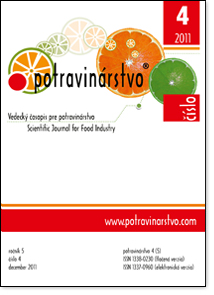Evaluation of the growth of selected Lactobacilli in pseudocereal substrate
DOI:
https://doi.org/10.5219/169Keywords:
probiotic, lactic acid bacteria, pseudocerealsAbstract
The growth dynamics of Lactobacillus spp. in sweet water- and milk-based substrates from cooked buckwheat
and amaranth flour were studied in this work. The numbers of lactobacilli were observed during fermentation in 5% CO2 atmosphere at 37 °C and storage (3 weeks at 6 °C). The earned data and estimated growth parameters showed that certain strains grew well in the milk-based gruels, even water-based amaranth gruel. This was also the case of the species under study characterized with the fastest growth. Based on the rates, only the strains of Lactobacillus rhamnosus GG and VT1 were able to grow with the values higher than 0.6 log CFU.ml-1.h-1 that can be expressed as the times to double (td) lower than 0.5 h. This was found in both the amaranth and buckwheat milk-based gruels and water-based amaranth gruels but fermented only by the probiotic GG strain. The 3-week storage tests aimed on survival of the lactobacilli at 6 °C showed minimal decrease of the counts in buckwheat gruels with the average rates of -0.084 and -0.004 log CFU.ml-1.d-1 in water- and milk-based gruels, respectively. On the other hand in amaranth gruels, the numbers of lactobacilli slightly increased with the rate of 0.02 log CFU.ml-1.d-1, on average. The results of this pilot study pointed out that the selection of suitable lactic acid bacteria should be performed for optimal fermentation of pseudo-cereal substrates. The numbers of lactobacilli at the end of fermentation were not or very slightly affected by the type of substrate at 6 °C during three weeks.
Downloads
Metrics
References
ADAMS, J. Celiac Disease Statistics, 2007. [online],
[cit. 16.11.2011]. Dostupné v:
http://www.celiac.com/articles/1164/1/Celiac-Disease-Statistics/Page1.html
ANGELOV, A., GOTCHEVA, V., KUNCHEVA, R., HRISTOZOVA, T., 2006. Development of a new oat-based probiotic drink. In International Journal of Food Microbiology, vol. 112, 2006, p. 75-80. DOI: https://doi.org/10.1016/j.ijfoodmicro.2006.05.015
BAI. J., ZEBALLOS, E., FRIED, M., CORAZZA, G.R., SCHUPPAN, D., FARTHING, M.J.G., CATASSI, C., GRECO, L., COHEN, H., KRABSHUIS, J.H., 2007. Celiac disease. In World Gastroenterology Organisation, 2007,
p. 1-18.
BURITI, F.C.A., DA ROCHA, J.S., ASSIS, E.G., SAAD, S.M.I., 2004. Probiotic potential of Minas fresh cheese prepared with the addition of Lactobacillus paracasei. DOI: https://doi.org/10.1016/j.lwt.2004.05.012
In Lebensmittel Wissenschaft und Technologie, vol. 38, 2004, p. 173 – 180.
CURRY, B., CROW, V., 2003. Lactobacillus spp. General characteristics. In: ROGINSKI, H., FUQUAY, J.W., FOX, P.W. Encyclopedia of Dairy Sciences. Academic Press, London, 3, 2003, p. 1479-1484. ISBN 0-12-227235-8. DOI: https://doi.org/10.1016/B0-12-227235-8/00238-8
FORESTIER, Ch., DE CHAMPS, Ch., VATOUX, C., JOLY, B., 2001. Probiotic activities of Lactobacillus casei rhamnosus: in vitro adherence to intestinal cells
and antimicrobial properties. In Res. Microbial., vol. 152, 2001, p. 167 – 173. DOI: https://doi.org/10.1016/S0923-2508(01)01188-3
GÖRNER, F., VALÍK, Ľ., 2004. Aplikovaná mikrobiológia požívatín. Malé centrum, Bratislava, 2004, 528 p.
ISBN 80-967064-9-7.
HELLAND, M.H., WICKLUND, T., NARVHUS, J.A., 2004. Growth and metabolism of selected strains of probiotic bacteria in milk- and water-based cereal puddings.
In International Dairy Journal, vol. 14, 2004, p. 957-965. DOI: https://doi.org/10.1016/j.idairyj.2004.03.008
CHARALAMPOPOULOS, D., WANG, R., PANDIELLA S.S., WEBB, C., 2002. Application of cereals and cereal components in functional foods: a review. In International Journal of Food Microbiology, vol. 79, 2002, p. 131–141. DOI: https://doi.org/10.1016/S0168-1605(02)00187-3
KOCKOVÁ, M., VALÍK, Ľ., 2011. Potential of cereals
and pseudocereals for lactic acid fermentations.
In Potravinárstvo, vol. 5, 2011, no. 2, p. 27-40. DOI: https://doi.org/10.1002/j.2637-496X.2011.tb00409.x
KOHAJDOVÁ, Z., KAROVIČOVÁ, J., MAGALA, M., 2011. Utilisation of chickpea flour for crackers production.
In Acta Chimica Slovaca, vol. 4, 2011, no. 2, p. 98-107.
KRAJČÍROVÁ, M., 2007. Celiakálna choroba v primárnej starostlivosti. In Pediatr. prax, vol. 5, 2007, p. 268-269.
LONNER, C., AKESSON, P.K., 1988. Acidification properties of lactic acid bacteria in rye sour doughs. In Food Microbiology, vol. 5, 1988, p. 43 – 58. DOI: https://doi.org/10.1016/0740-0020(88)90007-X
MATTILA-SANDHOLM, T., MATTO, J., SAARELA, M., 2009. Lactic acid bacteria with health claims- interactions
and interference with gastrointestinal flora. In International Dairy Journal, vol. 9, 2009, p. 25-35.
MERCENIER, A., PAVAN, S., POT, B., 2003. Probiotics as biotherapeutic agents: Present knowledge and future prospects. In Current Pharmaceutical Desifn, vol. 9, 2003, DOI: https://doi.org/10.2174/1381612033392224
p. 175-191.
MORONI, A.V., ARENDT, E.K., BELLO, F.D., 2011. Biodiversity of lactic acid bacteria and yeast
in spontaneously-fermented buckweath and teff sourdoughs. In Food Microbiology, vol. 28, 2011, p. 497-502. DOI: https://doi.org/10.1016/j.fm.2010.10.016
NEVORAL, J., 2005. Prebiotika, probiotika a synbiotika.
In Pediatrie pro praxi, vol. 2, 2005, p. 59-65.
PARVEZ, S., MALIK, K.A., AH KANG S., KIM, H.-Y., 2006. Probiotics and their fermented food products
are beneficial for health. In Journal of Applied Microbiology, vol. 100, 2006, p. 1171-1185. DOI: https://doi.org/10.1111/j.1365-2672.2006.02963.x
PRADO, F.C., PARADA, J.L., PANDEY, A., SOCCOL, C.R., 2008. Trends in non-dairy probiotic beverages. In Food Research International, vol. 41, 2008, p. 111-123. DOI: https://doi.org/10.1016/j.foodres.2007.10.010
SHAH, N.P., 2007. Functional cultures and health benefits. In International Dairy Journal, vol. 17, 2007, p. 1262-1277. DOI: https://doi.org/10.1016/j.idairyj.2007.01.014
STERR, Y., WEISS, A., SCHMIDT, H., 2009. Evaluation of lactic acid bacteria for sourdough fermentation
of amaranth. In International Journal of Food Microbiology, vol. 136, 2009, p. 75-82. DOI: https://doi.org/10.1016/j.ijfoodmicro.2009.09.006
STN ISO 15214, 2002. Mikrobiológia potravín a krmív: Horizontálna metóda stanovenia mezofilných baktérií mliečneho kysnutia. Metóda počítania kolónií kultivovaných pri 30 °C. Bratislava: Slovenský ústav technickej normalizácie, 2002.
TURČÁNI, M., MAASOVÁ, D., 2002. Sekundárna malabsorbcia. In: HULÍN, I. Patofyziológia, SAP, Bratislava, 2002, p. 950-952, ISBN 80-89104-05-3. DOI: https://doi.org/10.1063/1.1448398
VALÍK, Ľ., MEDVEĎOVÁ, A., LIPTÁKOVÁ, D., 2008. Characterization of the growth of Lactobacillus rhamnosus GG in milk at suboptimal temperatures. In Journal of Food and Nutrition Research, vol. 47, 2008, no. 2, p. 60-67.
Downloads
Published
How to Cite
Issue
Section
License
This license permits non-commercial re-use, distribution, and reproduction in any medium, provided the original work is properly cited, and is not altered, transformed, or built upon in any way.






























